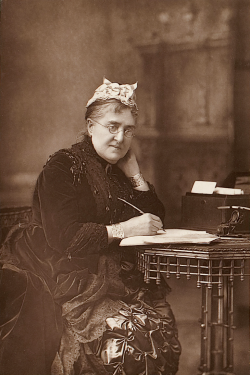

Queer Places:
Brantwood, East of Lake, Coniston LA21 8AD, UK
Gang Moor, Whitestone Ln, Hampstead, London NW3 6SR, UK
Crosthwaite Churchyard
Great Crosthwaite, Allerdale Borough, Cumbria, England
 Eliza
Lynn Linton (10 February 1822 – 14 July 1898) was the first woman
Salaried journalist (Morning Chronicle) in 1848. Linton was masculine and
erotically attracted to women but considered gender inversion a sign of
degeneracy and could only resolve her feelings by portraying herself as a man
in her writing.
Eliza
Lynn Linton (10 February 1822 – 14 July 1898) was the first woman
Salaried journalist (Morning Chronicle) in 1848. Linton was masculine and
erotically attracted to women but considered gender inversion a sign of
degeneracy and could only resolve her feelings by portraying herself as a man
in her writing.
She was the first female salaried journalist in Britain, and the author of over 20 novels. Despite her path breaking role as an independent woman, many of her essays took a strong anti-feminist slant.[1]
Eliza Lynn Linton was born in Keswick, Cumbria, England, the daughter of the Rev. J. Lynn, vicar of Crosthwaite, and granddaughter of a bishop of Carlisle. The death of her mother when Eliza was five months old led to a chaotic upbringing, in which she was largely self-educated; but in 1845 she left home to earn her living as a writer in London.[2] After moving to Paris, she married W. J. Linton in 1858,[3] an eminent wood-engraver, who was also a poet of some note, a writer upon his craft, and a Chartist agitator. She moved into his ramshackle house, Brantwood, in the Lakes, with his seven children from his earlier marriage, and wrote her Cumbrian novel Lizzie Lorton of Greyrigg there.[4] The couple also lived at Gang Moor on the edge of Hampstead Heath for several years.[5] In 1867 the couple separated in a friendly way, the husband going to America, Eliza going back to her life as a London writer. She returned briefly to Cumbria and to her childhood home in 1889, to feel "half in a dream here. It is Keswick and yet not Keswick, as I am Eliza Lynn and yet not Eliza Lynn".[6] She usually lived in London, but about three years before her death retired to Brougham House, Malvern. She died at Queen Anne's Mansions, London, on 14 July 1898,[7] and her ashes were scattered in the Crosthwaite churchyard.[8]
Linton arrived in London in 1845 as the protégée of poet Walter Savage Landor. In the following year she produced her first novel, Azeth, the Egyptian, which was succeeded by Amymone (1848), and Realities (1851). None of these had any great success, and she became a journalist, joining the staff of the Morning Chronicle and Household Words. After separating from her husband, Linton returned to writing novels, in which she finally attained wide popularity. Her most successful works were The True History of Joshua Davidson (1872), Patricia Kemball (1874), and The Autobiography of Christopher Kirkland (1885),[9] the latter being in fact a thinly disguised autobiography.[10] She was a constant contributor to the St James's Gazette, the Daily News and other leading newspapers,[11] and her 1864 guide to The Lake Country still bears reading for its tart comments on the tourist rituals of the Victorians.[12]
Mrs Linton was a severe critic of early feminism. Her most famous essay on this subject, "The Girl of the Period,"[13] was published in Saturday Review in 1868 and was a vehement attack on feminism. In 1891, she wrote "Wild Women as Politicians" which explained her opinion that politics was naturally the sphere of men, as was fame of any sort. "Amongst our most renowned women," she wrote, "are some who say with their whole heart, 'I would rather have been the wife of a great man, or the mother of a hero, than what I am, famous in my own person." Mrs Linton is a leading example of the fact that the fight against votes for women was not only organised by men, see Anti-suffragism. Her obituary in The Times noted her "animosity towards all, or rather, some of those facets which may be conveniently called the 'New Woman'," but added that "it would perhaps be difficult to reduce Mrs. Lynn Linton's views on what was and what was not desirable for her own sex to a logical and connected form." Revisionist critics have pointed in fact to an unconscious sympathy for the dashing "modern women" in her fiction,[14] as well as to her support for the right of married women to have their own property and thereby independence.[15] Her contribution to a symposium on English fiction in 1890 saw her take a less aggressive stance towards Grundyism than her fellow-contributor Thomas Hardy.[16]
My published books: